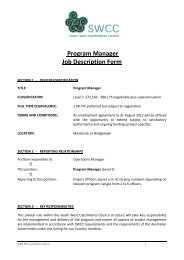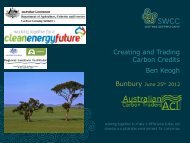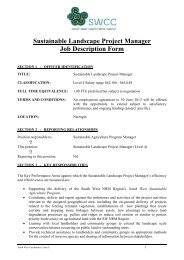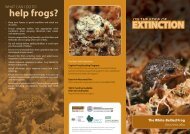Tender for the Programme - South West Catchments Council
Tender for the Programme - South West Catchments Council
Tender for the Programme - South West Catchments Council
You also want an ePaper? Increase the reach of your titles
YUMPU automatically turns print PDFs into web optimized ePapers that Google loves.
DRAFT<br />
<strong>South</strong> <strong>West</strong> Regional NRM Strategy – Ancillary Document<br />
Incorporate water sensitive urban design in all new developments<br />
Improve <strong>the</strong> agricultural and urban drainage system<br />
EPA 2008 Water Quality Improvement Plan <strong>for</strong> <strong>the</strong> rivers and estuary of <strong>the</strong> Peel-Harvey System –<br />
Phosphorus management. Environmental Protection Authority, Perth, <strong>West</strong>ern Australia, 78 pp.<br />
This WQIP identifies <strong>the</strong> current status of phosphorus loads; identifies <strong>the</strong> environmental values (EVs) of water bodies, and <strong>the</strong><br />
water quality objectives (WQOs) that will protect <strong>the</strong> EVs and identifies a set of management measures and control actions to<br />
achieve and maintain those EVs and WQOs.<br />
Evans, MC, JEM Watson, RA Fuller, O Venter, SC Bennett, PR Marsack and HP Possingham 2011<br />
The Spatial Distribution of Threats to Species in Australia. BioScience 61(4):281-289<br />
Conservation is ultimately about safeguarding biodiversity by arresting and reversing <strong>the</strong> impacts of threatening processes.<br />
Although data on <strong>the</strong> distributions of species are increasingly well resolved, <strong>the</strong> spatial distributions of threats to species are<br />
poorly understood. We mapped <strong>the</strong> distributions of eight major threats to Australia's threatened plants, vertebrates, and<br />
invertebrates using <strong>the</strong> geographic ranges of species affected by particular threats as surrogates <strong>for</strong> <strong>the</strong>ir spatial occurrence.<br />
Our results indicate that simply quantifying <strong>the</strong> proportion of species affected by particular threatening processes does not<br />
adequately capture <strong>the</strong> variation in <strong>the</strong> spatial extent, prevalence, or predominance of threats to species. Conservation planning<br />
is an inherently spatial process; <strong>the</strong>re<strong>for</strong>e, explicitly considering <strong>the</strong> spatial dimension of threats could significantly enhance our<br />
ability to direct ef<strong>for</strong>ts to areas where <strong>the</strong> greatest conservation outcomes can be delivered.<br />
http://conservationbytes.com/2011/06/09/know-thy-threat/#more-5802<br />
Finning, S, A Hams and J Steele 2008 Lower Harvey River Rehabilitation Plan. Technical report<br />
prepared <strong>for</strong> <strong>the</strong> Harvey River Restoration Trust, Harvey, WA. 24 pp.<br />
The report describes <strong>the</strong> Harvey River, which has undergone severe alteration from its natural state in terms of channel<br />
morphology and regional hydrology. The loss of riparian vegetation has had enormous ramifications on water quality and<br />
stream morphological processes (extensive sedimentation and eutrophication) leading to a loss of ecological diversity. Report<br />
discusses rehabilitation, showing it should focus on preserving <strong>the</strong> remaining vegetation and allowing <strong>the</strong> river to continue to<br />
evolve, with <strong>the</strong> addition of large woody debris to increase turbulence, re-oxygenate <strong>the</strong> flow and create fauna habitat. Small<br />
deconstruction of levee banks in places where steepness is excessive and contributing to erosion should also be carried out,<br />
and in <strong>the</strong> short-term banks should be stabilised with matting until native vegetation is well established. Current drainage<br />
management practices of manually clearing sediment from <strong>the</strong> River and increasing <strong>the</strong> heights of <strong>the</strong> levee banks should<br />
cease so as to enable <strong>the</strong> reconnection of <strong>the</strong> floodplain and bank stabilisation to continue.<br />
Froend, R and R Loomes 2006 Determination of ecological water requirements <strong>for</strong> wetland and<br />
terrestrial vegetation – sou<strong>the</strong>rn Blackwood and eastern Scott coastal plain. Report to Department of<br />
Water, Centre <strong>for</strong> Ecosystem Management, Joondalup, WA. 147 pp.<br />
This study is useful <strong>for</strong> managers and builds on a previous URS study and establishes site-specific water regime criteria <strong>for</strong><br />
selected wetlands and representative phreatophytic vegetation within <strong>the</strong> eastern Scott and sou<strong>the</strong>rn Blackwood area. The<br />
study covers 1) Identification of phreatophytic vegetation criteria sites; 2) Establishment of wetland and terrestrial vegetation<br />
transects and baseline monitoring; 3) Proposal of ecological management objectives; 4) Determination of ecological water<br />
requirements; 5) Description of possible impacts due to water level decline; and 6) Proposal of monitoring regimes.<br />
GAO 2011 Climate engineering – Technical status, future directions, and potential responses. Report<br />
to Congressional Requester, Center <strong>for</strong> Science, Technology, and Engineering, United States<br />
Government Accountability Office GAO. 135 pp.<br />
Reports of rising global temperatures have raised questions about responses to climate change, including ef<strong>for</strong>ts to (1) reduce<br />
carbon dioxide (CO2) emissions, (2) adapt to climate change, and (3) design and develop climate engineering technologies <strong>for</strong><br />
deliberate, large-scale intervention in Earth's climate. Reporting earlier that <strong>the</strong> nation lacks a coordinated climate-change<br />
strategy that includes climate engineering, this report assesses climate engineering technologies, focusing on <strong>the</strong>ir technical<br />
status, future directions <strong>for</strong> research on <strong>the</strong>m, and potential responses. To per<strong>for</strong>m this technology assessment, GAO reviewed<br />
<strong>the</strong> peer-reviewed scientific literature and government reports, consulted experts with a wide variety of backgrounds and<br />
viewpoints, and surveyed 1,006 adults across <strong>the</strong> United States. The conclusion was that climate engineering technologies do<br />
not now offer a viable response to global climate change. Experts advocating research to develop and evaluate <strong>the</strong> technologies<br />
believe that research on <strong>the</strong>se technologies is urgently needed or would provide an insurance policy against worst-case climate<br />
scenarios - but caution that <strong>the</strong> misuse of research could bring new risks. The technologies being proposed have been<br />
categorized as carbon dioxide removal (CDR) and solar radiation management (SRM). GAO found <strong>the</strong>se technologies to be<br />
currently immature, many with potentially negative consequences.<br />
Geocatch 2008 Geographe catchment management strategy – 2008. Geographe Catchment <strong>Council</strong>,<br />
Busselton, WA. 46 pp.<br />
Key strategy produced by one of six sub-regional catchment management groups, listing key threats and priority actions to<br />
address <strong>the</strong>se. Only key threats (issues) are discussed under <strong>the</strong> headings water, land, biodiversity, marine & coast, people<br />
and climate. The major assets of <strong>the</strong> region are also described in <strong>the</strong> text but not prioritised.<br />
GHD 2007 Status of State Salinity Framework – Report. Report to SWCC, GHD Consultants, Perth<br />
WA. 40 pp.<br />
11






